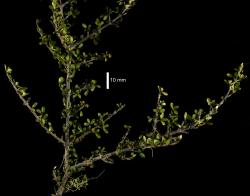- Taxon
- Gallery
Divaricating shrub 1–3 m tall. Branches sympodial, long shoots modular, apices aborting at 5–10 cm or occasionally not aborting in shaded specimens, often conspicuously arched and decurved in open sites, bark pale grey or brown, smooth or with longitudinal ridges, final branchlets pubescent. Brachyblasts with internodes c. 1 mm. Leaves glabrous, usually pale green above and below, often pale or darker brown, oblong or narrow-oblong, 3–8(–10) mm × 1– 1.5(–3) mm, sometimes slightly falcate, flat not keeled, apex rounded with minute tuft or rim of hairs, base rounded sometimes almost cuneate, margins often somewhat thickened and reddish, midrib usually visible only below, primary veins sometimes visible below. Domatia 0–3, 0.6 mm across, ciliate, shallow. Petiole to 1 mm, glabrous, abscission zone present. Stipules 0.8 mm long, triangular, pubescent, sheath ¼ length of stipule, ciliate, denticles c. 6, obscured by cilia. Male flowers solitary, occasionally paired laterally below leafy portion of long shoot or clustered below leaves on brachyblasts, with 2– 3 basal involucels each formed by stipular ring with 2 linear emergences corresponding to leaves in position, the rest of the ring ciliate, more or less truncate, sometimes with 2 triangular or rounded lobe s in stipular position, calyx 0, corolla campanulate, 2 mm long, lobes free for ½-2/3 their length, acute, eventually recurved, filaments hardly elongating, attached at very base of corolla. Female flowers solitary, basal involucel becoming pale and chaffy, 2 linear lobes in leaf position, 2 oblong lobes in stipule position, second involucel with similar structure but larger and remaining green, stipule lobes sometimes with central tuft of hairs, calyx a simple ciliate ring with hairs sometimes grouped irregularly into tufts, corolla campanulate, 1-1.5 mm long, lobes free for ½ their length, recurved, linear, acute, glabrous, style arms 2, rarely 3, free, to 4 mm long. Drupe globose or slightly flattened at poles, 5–7 × 4–6 mm, skin red, flesh orange, pyrenes (1)–2–(3), often unequal, if 2 then more or less plano-convex, 2–4 mm long. 2n = 44.
[Reproduced from Heads (1998, New Zealand J. Bot. 36: 65-69) with permission from The Royal Society of New Zealand.]




